Spatial and Temporal Inconsistency of Forest Resilience and Forest Vegetation Greening in Southwest China Under Climate Change
Abstract
1. Introduction
2. Results
2.1. Spatial and Temporal Changes in Forest Resilience
2.2. Classification and Spatial Distribution Characteristics of Forest Resilience Trends
2.3. Coupling of Forest Vegetation Greening and Forest Resilience
2.4. Analysis of Drivers of Forest Resilience
3. Discussion
3.1. Types of Spatial and Temporal Distribution Patterns and Trends in Forest Resilience
3.2. Coupling Forest Vegetation Greening with Forest Resilience
3.3. Drivers of Change in Forest Resilience
3.4. Shortcomings and Outlook
4. Materials and Methods
4.1. Study Area
4.2. Data Sources
4.3. Methods
4.3.1. Forest Resilience Indicators
4.3.2. Forest Resilience Classification Methodology
4.3.3. Methodology for Analyzing Drivers of Forest Resilience
- (1)
- Random Forest Regression Model
- (2)
- Shapley Additive Explanations
5. Conclusions
- (1)
- Forest resilience in Southwest China exhibited a spatial pattern of “high in the northwest and low in the southeast,” with a temporal evolution characterized by a “strengthening–weakening–strengthening” trajectory. Key turning points were identified around 2010 and 2015.
- (2)
- More than 90% of forest pixels experienced at least one trend shift during the study period, which could be categorized into six typical trajectories. Among them, the “increase-to-decrease” (ITD, 28.8%) and “decrease-to-increase” (DTI, 27.7%) types were dominant, while the “monotonically decreasing” (MD, 3.1%) type was mainly concentrated in central–western Yunnan, representing areas at high risk of ecological degradation. These dynamic patterns highlight the nonlinear and stage-dependent nature of forest resilience.
- (3)
- Vegetation greening does not necessarily indicate improved resilience. During the resilience enhancement phase, 81% of pixels in the MI (Monotonic Increase) category exhibited synchronous increases in both the kNDVI and resilience. However, in the resilience degradation phase, 82% of MD-type pixels showed an asynchronous pattern, where “greening occurred while resilience declined.” Similar mismatches were observed across other trend types, suggesting that the kNDVI alone cannot reliably reflect the true recovery status of ecosystems. The risk of “greening masking degradation” should not be overlooked.
- (4)
- Forest resilience was primarily driven by climatic factors, exhibiting nonlinear and threshold responses. SHAP analysis identified key variables such as the mean annual temperature, precipitation, and kNDVI. Warming and increased solar radiation were found to weaken resilience, while increased precipitation contributed to resilience enhancement. The effects of climatic variability on resilience followed a quadratic relationship, highlighting the sensitivity of ecosystems to climate disturbances in different contexts.
Author Contributions
Funding
Data Availability Statement
Acknowledgments
Conflicts of Interest
References
- Friedlingstein, P.; Jones, M.W.; O’Sullivan, M.; Andrew, R.M.; Bakker, D.C.; Hauck, J.; Le Quéré, C.; Peters, G.P.; Peters, W.; Pongratz, J. Global carbon budget 2021. Earth Syst. Sci. Data 2022, 14, 1917–2005. [Google Scholar] [CrossRef]
- Pan, Y.; Birdsey, R.A.; Fang, J.; Houghton, R.; Kauppi, P.E.; Kurz, W.A.; Phillips, O.L.; Shvidenko, A.; Lewis, S.L.; Canadell, J.G. A large and persistent carbon sink in the world’s forests. Science 2011, 333, 988–993. [Google Scholar] [CrossRef] [PubMed]
- Thompson, I.; Mackey, B.; McNulty, S.; Mosseler, A. A Synthesis of the biodiversity/resilience/stability relationship in forest ecosystems. In Proceedings of the Forest Resilience, Biodiversity, and Climate Change; Technical Series. Secretariat of the Convention on Biological Diversity: Montreal, QC, Canada, 2009; p. 67. [Google Scholar]
- Dakos, V.; Carpenter, S.R.; van Nes, E.H.; Scheffer, M. Resilience indicators: Prospects and limitations for early warnings of regime shifts. Philos. Trans. R. Soc. B Biol. Sci. 2015, 370, 20130263. [Google Scholar] [CrossRef]
- Ibáñez, I.; Acharya, K.; Juno, E.; Karounos, C.; Lee, B.R.; McCollum, C.; Schaffer-Morrison, S.; Tourville, J. Forest resilience under global environmental change: Do we have the information we need? A systematic review. PLoS ONE 2019, 14, e0222207. [Google Scholar] [CrossRef] [PubMed]
- Holling, C.S. Resilience and Stability of Ecological Systems; Annual Reviews: San Mateo, CA, USA, 1973. [Google Scholar]
- Pimm, S.L. The complexity and stability of ecosystems. Nature 1984, 307, 321–326. [Google Scholar] [CrossRef]
- Willis, K.J.; Jeffers, E.S.; Tovar, C. What makes a terrestrial ecosystem resilient? Science 2018, 359, 988–989. [Google Scholar] [CrossRef]
- Dakos, V.; Matthews, B.; Hendry, A.P.; Levine, J.; Loeuille, N.; Norberg, J.; Nosil, P.; Scheffer, M.; De Meester, L. Ecosystem tipping points in an evolving world. Nat. Ecol. Evol. 2019, 3, 355–362. [Google Scholar] [CrossRef]
- Seidl, R.; Thom, D.; Kautz, M.; Martin-Benito, D.; Peltoniemi, M.; Vacchiano, G.; Wild, J.; Ascoli, D.; Petr, M.; Honkaniemi, J. Forest disturbances under climate change. Nat. Clim. Change 2017, 7, 395–402. [Google Scholar] [CrossRef]
- Scheffer, M.; Bascompte, J.; Brock, W.A.; Brovkin, V.; Carpenter, S.R.; Dakos, V.; Held, H.; Van Nes, E.H.; Rietkerk, M.; Sugihara, G. Early-warning signals for critical transitions. Nature 2009, 461, 53–59. [Google Scholar] [CrossRef]
- Hodgson, D.; McDonald, J.L.; Hosken, D.J. What do you mean,’resilient’? Trends Ecol. Evol. 2015, 30, 503–506. [Google Scholar] [CrossRef]
- Abis, B.; Brovkin, V. Environmental conditions for alternative tree-cover states in high latitudes. Biogeosciences 2017, 14, 511–527. [Google Scholar] [CrossRef]
- Verbesselt, J.; Umlauf, N.; Hirota, M.; Holmgren, M.; Van Nes, E.H.; Herold, M.; Zeileis, A.; Scheffer, M. Remotely sensed resilience of tropical forests. Nat. Clim. Change 2016, 6, 1028–1031. [Google Scholar] [CrossRef]
- Boers, N.; Rypdal, M. Critical slowing down suggests that the western Greenland Ice Sheet is close to a tipping point. Proc. Natl. Acad. Sci. USA 2021, 118, e2024192118. [Google Scholar] [CrossRef]
- Boers, N.; Ghil, M.; Stocker, T.F. Theoretical and paleoclimatic evidence for abrupt transitions in the Earth system. Environ. Res. Lett. 2022, 17, 093006. [Google Scholar] [CrossRef]
- Dakos, V.; Van Nes, E.H.; d’Odorico, P.; Scheffer, M. Robustness of variance and autocorrelation as indicators of critical slowing down. Ecology 2012, 93, 264–271. [Google Scholar] [CrossRef] [PubMed]
- Smith, T.; Traxl, D.; Boers, N. Empirical evidence for recent global shifts in vegetation resilience. Nat. Clim. Change 2022, 12, 477–484. [Google Scholar] [CrossRef]
- Tao, S.; Wigneron, J.-P.; Chave, J.; Tang, Z.; Wang, Z.; Zhu, J.; Guo, Q.; Liu, Y.Y.; Ciais, P. Little evidence that Amazonian rainforests are approaching a tipping point. Nat. Clim. Change 2023, 13, 1317–1320. [Google Scholar] [CrossRef]
- Forzieri, G.; Dakos, V.; McDowell, N.G.; Ramdane, A.; Cescatti, A. Emerging signals of declining forest resilience under climate change. Nature 2022, 608, 534–539. [Google Scholar] [CrossRef]
- Boulton, C.A.; Lenton, T.M.; Boers, N. Pronounced loss of Amazon rainforest resilience since the early 2000s. Nat. Clim. Change 2022, 12, 271–278. [Google Scholar] [CrossRef]
- Feng, Y.; Su, H.; Tang, Z.; Wang, S.; Zhao, X.; Zhang, H.; Ji, C.; Zhu, J.; Xie, P.; Fang, J. Reduced resilience of terrestrial ecosystems locally is not reflected on a global scale. Commun. Earth Environ. 2021, 2, 88. [Google Scholar] [CrossRef]
- Fang, O.; Zhang, Q.B. Tree resilience to drought increases in the Tibetan Plateau. Glob. Change Biol. 2019, 25, 245–253. [Google Scholar] [CrossRef]
- Müller, M.; Olsson, P.-O.; Eklundh, L.; Jamali, S.; Ardö, J. Response and resilience to drought in northern forests revealed by Sentinel-2. Int. J. Remote Sens. 2024, 45, 5130–5157. [Google Scholar] [CrossRef]
- Kacic, P.; Gessner, U.; Holzwarth, S.; Thonfeld, F.; Kuenzer, C. Assessing experimental silvicultural treatments enhancing structural complexity in a central European forest–BEAST time-series analysis based on Sentinel-1 and Sentinel-2. Remote Sens. Ecol. Conserv. 2024, 10, 531–550. [Google Scholar] [CrossRef]
- Chen, C.; Park, T.; Wang, X.; Piao, S.; Xu, B.; Chaturvedi, R.K.; Fuchs, R.; Brovkin, V.; Ciais, P.; Fensholt, R. China and India lead in greening of the world through land-use management. Nat. Sustain. 2019, 2, 122–129. [Google Scholar] [CrossRef]
- Piao, S.; Wang, X.; Park, T.; Chen, C.; Lian, X.; He, Y.; Bjerke, J.W.; Chen, A.; Ciais, P.; Tømmervik, H. Characteristics, drivers and feedbacks of global greening. Nat. Rev. Earth Environ. 2020, 1, 14–27. [Google Scholar] [CrossRef]
- Hu, Y.; Wei, F.; Fu, B.; Wang, S.; Zhang, W.; Zhang, Y. Changes and influencing factors of ecosystem resilience in China. Environ. Res. Lett. 2023, 18, 094012. [Google Scholar] [CrossRef]
- McDowell, N.G.; Allen, C.D.; Anderson-Teixeira, K.; Aukema, B.H.; Bond-Lamberty, B.; Chini, L.; Clark, J.S.; Dietze, M.; Grossiord, C.; Hanbury-Brown, A. Pervasive shifts in forest dynamics in a changing world. Science 2020, 368, eaaz9463. [Google Scholar] [CrossRef] [PubMed]
- Wang, Z.; Fu, B.; Wu, X.; Li, Y.; Feng, Y.; Wang, S.; Wei, F.; Zhang, L. Vegetation resilience does not increase consistently with greening in China’s Loess Plateau. Commun. Earth Environ. 2023, 4, 336. [Google Scholar] [CrossRef]
- Liu, C.; Liu, Y.; Guo, K.; Wang, S.; Liu, H.; Zhao, H.; Qiao, X.; Hou, D.; Li, S. Aboveground carbon stock, allocation and sequestration potential during vegetation recovery in the karst region of southwestern China: A case study at a watershed scale. Agric. Ecosyst. Environ. 2016, 235, 91–100. [Google Scholar] [CrossRef]
- Piao, S.; Fang, J.; Ciais, P.; Peylin, P.; Huang, Y.; Sitch, S.; Wang, T. The carbon balance of terrestrial ecosystems in China. Nature 2009, 458, 1009–1013. [Google Scholar] [CrossRef] [PubMed]
- Fan, L.; Dong, G.; Frappart, F.; Wigneron, J.-P.; Yue, Y.; Xiao, X.; Zhang, Y.; Tao, S.; Cao, L.; Li, Y. Satellite-observed increase in aboveground carbon over Southwest China during 2013–2021. J. Remote Sens. 2024, 4, 0113. [Google Scholar] [CrossRef]
- Song, L.; Li, Y.; Ren, Y.; Wu, X.; Guo, B.; Tang, X.; Shi, W.; Ma, M.; Han, X.; Zhao, L. Divergent vegetation responses to extreme spring and summer droughts in Southwestern China. Agric. For. Meteorol. 2019, 279, 107703. [Google Scholar] [CrossRef]
- He, Y.; Manful, D.; Warren, R.; Forstenhäusler, N.; Osborn, T.J.; Price, J.; Jenkins, R.; Wallace, C.; Yamazaki, D. Quantification of impacts between 1.5 and 4 C of global warming on flooding risks in six countries. Clim. Change 2022, 170, 15. [Google Scholar] [CrossRef]
- Smith, T.; Boers, N. Global vegetation resilience linked to water availability and variability. Nat. Commun. 2023, 14, 498. [Google Scholar] [CrossRef] [PubMed]
- Jiang, H.; Song, L.; Li, Y.; Ma, M.; Fan, L. Monitoring the reduced resilience of forests in southwest China using long-term remote sensing data. Remote Sens. 2021, 14, 32. [Google Scholar] [CrossRef]
- Cai, M.; Zhang, Y.; Guan, X.; Qiu, J. An adaptive spatiotemporal tensor reconstruction method for GIMMS-3g+ NDVI. Remote Sens. Environ. 2025, 316, 114511. [Google Scholar] [CrossRef]
- Liu, S.; Zhang, W.; Wang, K.; Pan, F.; Yang, S.; Shu, S. Factors controlling accumulation of soil organic carbon along vegetation succession in a typical karst region in Southwest China. Sci. Total Environ. 2015, 521, 52–58. [Google Scholar] [CrossRef]
- Guo, Y.; Zhang, X.; Wang, Q.; Chen, H.; Du, X.; Ma, Y. Temporal changes in vegetation around a shale gas development area in a subtropical karst region in southwestern China. Sci. Total Environ. 2020, 701, 134769. [Google Scholar] [CrossRef]
- Li, Q.; Yue, Y.; Liu, S.; Brandt, M.; Chen, Z.; Tong, X.; Wang, K.; Chang, J.; Fensholt, R. Beyond tree cover: Characterizing southern China’s forests using deep learning. Remote Sens. Ecol. Conserv. 2023, 9, 17–32. [Google Scholar] [CrossRef]
- Shao, H.; Zhang, Y.; Yu, Z.; Gu, F.; Peng, Z. The resilience of vegetation to the 2009/2010 extreme drought in southwest China. Forests 2022, 13, 851. [Google Scholar] [CrossRef]
- Zhou, L.; Wang, S.; Chi, Y.; Wang, J. Drought impacts on vegetation indices and productivity of terrestrial ecosystems in southwestern China during 2001–2012. Chin. Geogr. Sci. 2018, 28, 784–796. [Google Scholar] [CrossRef]
- Zhang, L.; Xiao, J.; Li, J.; Wang, K.; Lei, L.; Guo, H. The 2010 spring drought reduced primary productivity in southwestern China. Environ. Res. Lett. 2012, 7, 045706. [Google Scholar] [CrossRef]
- Chen, J.; Wang, S.; Shi, H.; Chen, B.; Wang, J.; Zheng, C.; Zhu, K. Radiation and temperature dominate the spatiotemporal variability in resilience of subtropical evergreen forests in China. Front. For. Glob. Change 2023, 6, 1166481. [Google Scholar] [CrossRef]
- Wang, J.; Zhu, Y.; Liu, Y.; Zhang, X. Spatio-temporal characteristics and evolution trends of vegetation resilience in China from 2000 to 2022. Trans. Chin. Soc. Agric. Eng. 2025, 41, 136–143. [Google Scholar]
- Falk, D.A.; van Mantgem, P.J.; Keeley, J.E.; Gregg, R.M.; Guiterman, C.H.; Tepley, A.J.; Young, D.J.; Marshall, L.A. Mechanisms of forest resilience. For. Ecol. Manag. 2022, 512, 120129. [Google Scholar] [CrossRef]
- Zhou, L.; Wang, X.; Wang, Z.; Zhang, X.; Chen, C.; Liu, H. The challenge of soil loss control and vegetation restoration in the karst area of southwestern China. Int. Soil Water Conserv. Res. 2020, 8, 26–34. [Google Scholar] [CrossRef]
- Liao, C.; Yue, Y.; Wang, K.; Fensholt, R.; Tong, X.; Brandt, M. Ecological restoration enhances ecosystem health in the karst regions of southwest China. Ecol. Indic. 2018, 90, 416–425. [Google Scholar] [CrossRef]
- Huang, Z.; Liu, X.; Yang, Q.; Meng, Y.; Zhu, L.; Zou, X. Quantifying the spatiotemporal characteristics of multi-dimensional karst ecosystem stability with Landsat time series in southwest China. Int. J. Appl. Earth Obs. Geoinf. 2021, 104, 102575. [Google Scholar] [CrossRef]
- Liu, Y.; Kumar, M.; Katul, G.G.; Porporato, A. Reduced resilience as an early warning signal of forest mortality. Nat. Clim. Change 2019, 9, 880–885. [Google Scholar] [CrossRef]
- Chen, H.; Liu, J.; He, W.; Xu, P.; Nguyen, N.T.; Lv, Y.; Huang, C. Shifted vegetation resilience from loss to gain driven by changes in water availability and solar radiation over the last two decades in Southwest China. Agric. For. Meteorol. 2025, 368, 110543. [Google Scholar] [CrossRef]
- Harris, N.L.; Gibbs, D.A.; Baccini, A.; Birdsey, R.A.; De Bruin, S.; Farina, M.; Fatoyinbo, L.; Hansen, M.C.; Herold, M.; Houghton, R.A. Global maps of twenty-first century forest carbon fluxes. Nat. Clim. Change 2021, 11, 234–240. [Google Scholar] [CrossRef]
- Jump, A.S.; Ruiz-Benito, P.; Greenwood, S.; Allen, C.D.; Kitzberger, T.; Fensham, R.; Martínez-Vilalta, J.; Lloret, F. Structural overshoot of tree growth with climate variability and the global spectrum of drought-induced forest dieback. Glob. Change Biol. 2017, 23, 3742–3757. [Google Scholar] [CrossRef] [PubMed]
- Zhang, Y.; Keenan, T.F.; Zhou, S. Exacerbated drought impacts on global ecosystems due to structural overshoot. Nat. Ecol. Evol. 2021, 5, 1490–1498. [Google Scholar] [CrossRef]
- Tiantian, C.; Qiang, W.; Yuxi, W.; Li, P. Differentiation characteristics of karst vegetation resilience and its response to climate and ecological restoration projects. Land Degrad. Dev. 2023, 34, 5055–5070. [Google Scholar] [CrossRef]
- Gao, X.; Liang, S.; Sauer, J. Greening hiatus in Eurasian boreal forests since 1997 caused by a wetting and cooling summer climate. J. Geophys. Res. Biogeosci. 2020, 125, e2020JG005662. [Google Scholar] [CrossRef]
- Randazzo, N.A.; Michalak, A.M.; Miller, C.E.; Miller, S.M.; Shiga, Y.P.; Fang, Y. Higher autumn temperatures lead to contrasting CO2 flux responses in boreal forests versus tundra and shrubland. Geophys. Res. Lett. 2021, 48, e2021GL093843. [Google Scholar] [CrossRef]
- Jiang, L.; Liu, B.; Yuan, Y. Quantifying Vegetation Vulnerability to Climate Variability in China. Remote Sens. 2022, 14, 3491. [Google Scholar] [CrossRef]
- Yan, Y.; Dai, Q.; Jin, L.; Wang, X. Geometric morphology and soil properties of shallow karst fissures in an area of karst rocky desertification in SW China. Catena 2019, 174, 48–58. [Google Scholar] [CrossRef]
- Liu, Z.; Zhu, J.; Xia, J.; Huang, K. Declining resistance of vegetation productivity to droughts across global biomes. Agric. For. Meteorol. 2023, 340, 109602. [Google Scholar] [CrossRef]
- Yao, Y.; Liu, Y.; Fu, F.; Song, J.; Wang, Y.; Han, Y.; Wu, T.; Fu, B. Declined terrestrial ecosystem resilience. Glob. Change Biol. 2024, 30, e17291. [Google Scholar] [CrossRef] [PubMed]
- Wang, H.; Ciais, P.; Sitch, S.; Green, J.K.; Tao, S.; Fu, Z.; Albergel, C.; Bastos, A.; Wang, M.; Fawcett, D. Anthropogenic disturbance exacerbates resilience loss in the Amazon rainforests. Glob. Change Biol. 2024, 30, e17006. [Google Scholar] [CrossRef]
- Camps-Valls, G.; Campos-Taberner, M.; Moreno-Martínez, Á.; Walther, S.; Duveiller, G.; Cescatti, A.; Mahecha, M.D.; Muñoz-Marí, J.; García-Haro, F.J.; Guanter, L. A unified vegetation index for quantifying the terrestrial biosphere. Sci. Adv. 2021, 7, eabc7447. [Google Scholar] [CrossRef] [PubMed]
- Zhao, K.; Wulder, M.A.; Hu, T.; Bright, R.; Wu, Q.; Qin, H.; Li, Y.; Toman, E.; Mallick, B.; Zhang, X. Detecting change-point, trend, and seasonality in satellite time series data to track abrupt changes and nonlinear dynamics: A Bayesian ensemble algorithm. Remote Sens. Environ. 2019, 232, 111181. [Google Scholar] [CrossRef]
- Dashti, H.; Chen, M.; Smith, W.K.; Zhao, K.; Moore, D.J. Ecosystems disturbance recovery: What it was or what it could have been? Geophys. Res. Lett. 2024, 51, e2024GL109219. [Google Scholar] [CrossRef]
- Dashti, H.; Pandit, K.; Glenn, N.F.; Shinneman, D.J.; Flerchinger, G.N.; Hudak, A.T.; de Graaf, M.A.; Flores, A.; Ustin, S.; Ilangakoon, N. Performance of the ecosystem demography model (EDv2. 2) in simulating gross primary production capacity and activity in a dryland study area. Agric. For. Meteorol. 2021, 297, 108270. [Google Scholar] [CrossRef]
- Li, J.; Li, Z.-L.; Wu, H.; You, N. Trend, seasonality, and abrupt change detection method for land surface temperature time-series analysis: Evaluation and improvement. Remote Sens. Environ. 2022, 280, 113222. [Google Scholar] [CrossRef]
- Green, J.K.; Ballantyne, A.; Abramoff, R.; Gentine, P.; Makowski, D.; Ciais, P. Surface temperatures reveal the patterns of vegetation water stress and their environmental drivers across the tropical Americas. Glob. Change Biol. 2022, 28, 2940–2955. [Google Scholar] [CrossRef]
- Wang, Z.; Lai, C.; Chen, X.; Yang, B.; Zhao, S.; Bai, X. Flood hazard risk assessment model based on random forest. J. Hydrol. 2015, 527, 1130–1141. [Google Scholar] [CrossRef]
- Willmott, C.J.; Ackleson, S.G.; Davis, R.E.; Feddema, J.J.; Klink, K.M.; Legates, D.R.; O’donnell, J.; Rowe, C.M. Statistics for the evaluation and comparison of models. J. Geophys. Res. Ocean. 1985, 90, 8995–9005. [Google Scholar] [CrossRef]
- Lundberg, S.M.; Erion, G.; Chen, H.; DeGrave, A.; Prutkin, J.M.; Nair, B.; Katz, R.; Himmelfarb, J.; Bansal, N.; Lee, S.-I. From local explanations to global understanding with explainable AI for trees. Nat. Mach. Intell. 2020, 2, 56–67. [Google Scholar] [CrossRef]
- Lundberg, S.M.; Lee, S.-I. A unified approach to interpreting model predictions. Adv. Neural Inf. Process. Syst. 2017, 30, 4768–4777. [Google Scholar]
- Rodríguez-Pérez, R.; Bajorath, J. Interpretation of machine learning models using shapley values: Application to compound potency and multi-target activity predictions. J. Comput.-Aided Mol. Des. 2020, 34, 1013–1026. [Google Scholar] [CrossRef] [PubMed]

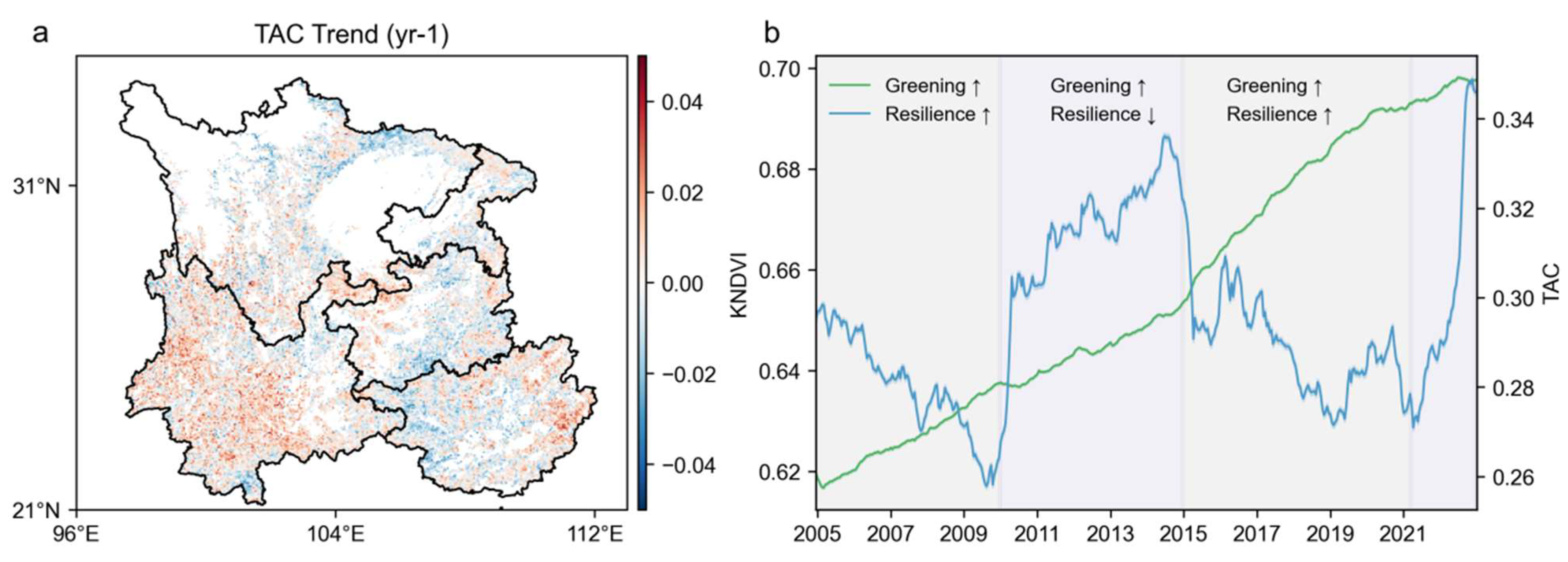

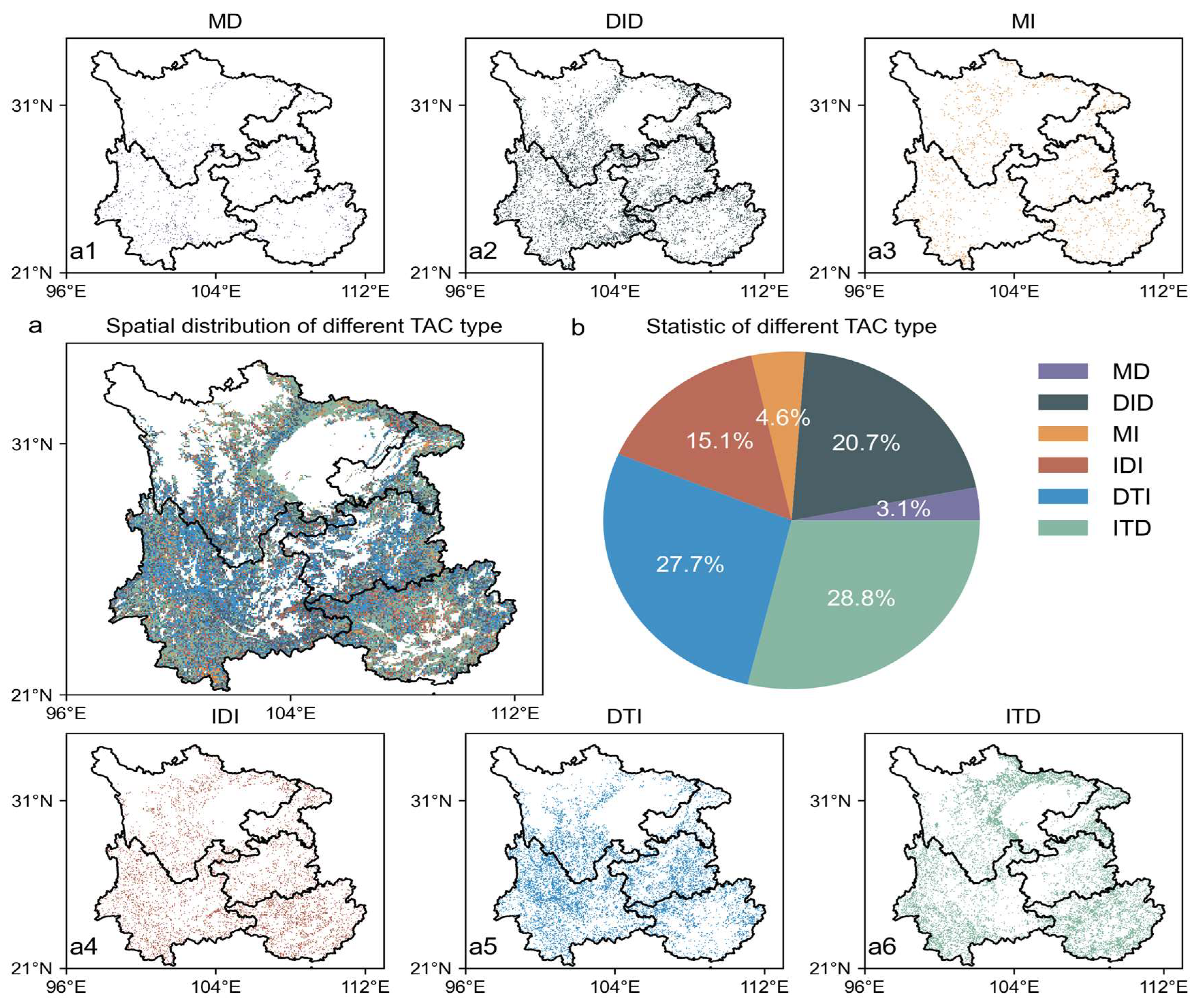

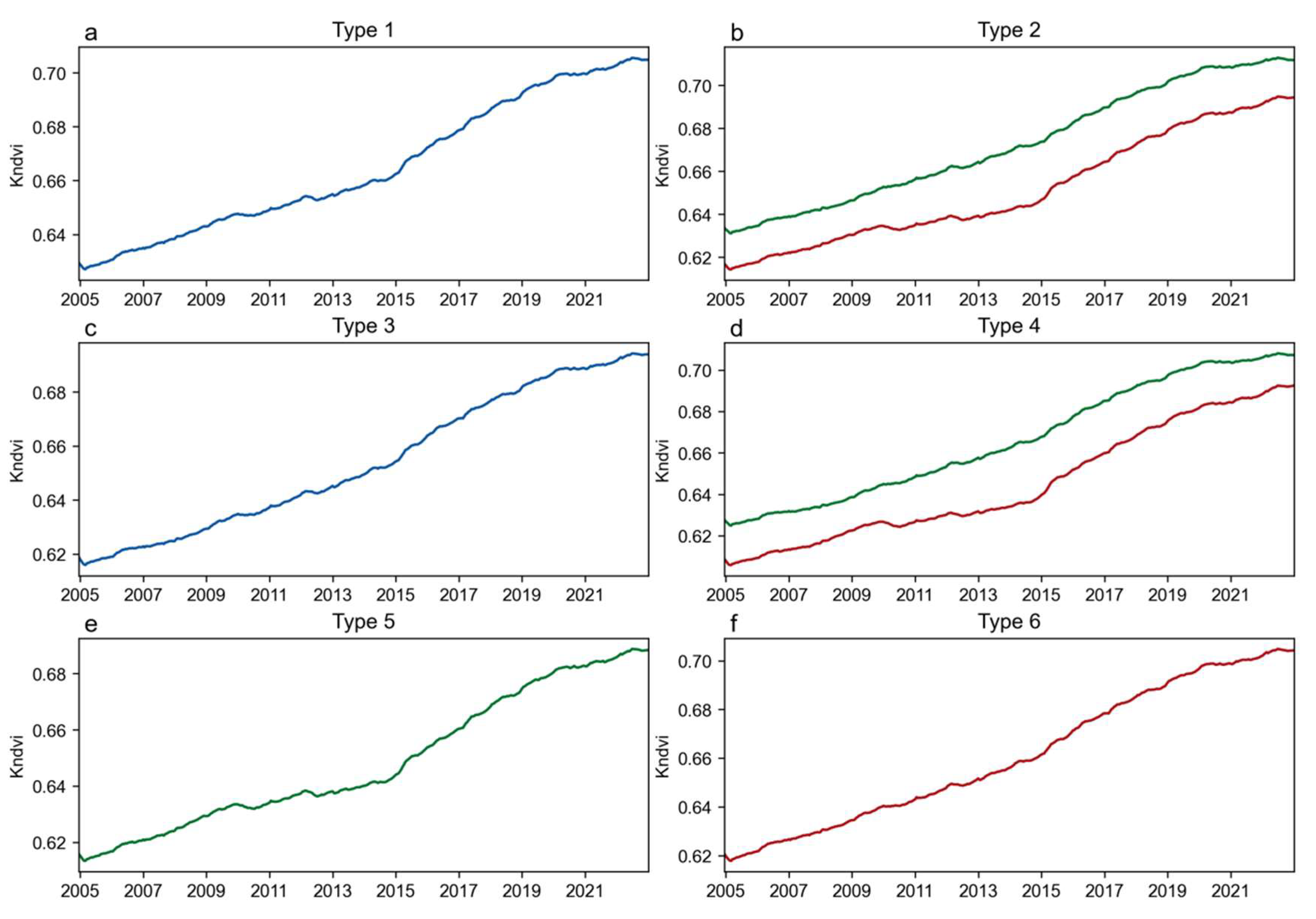
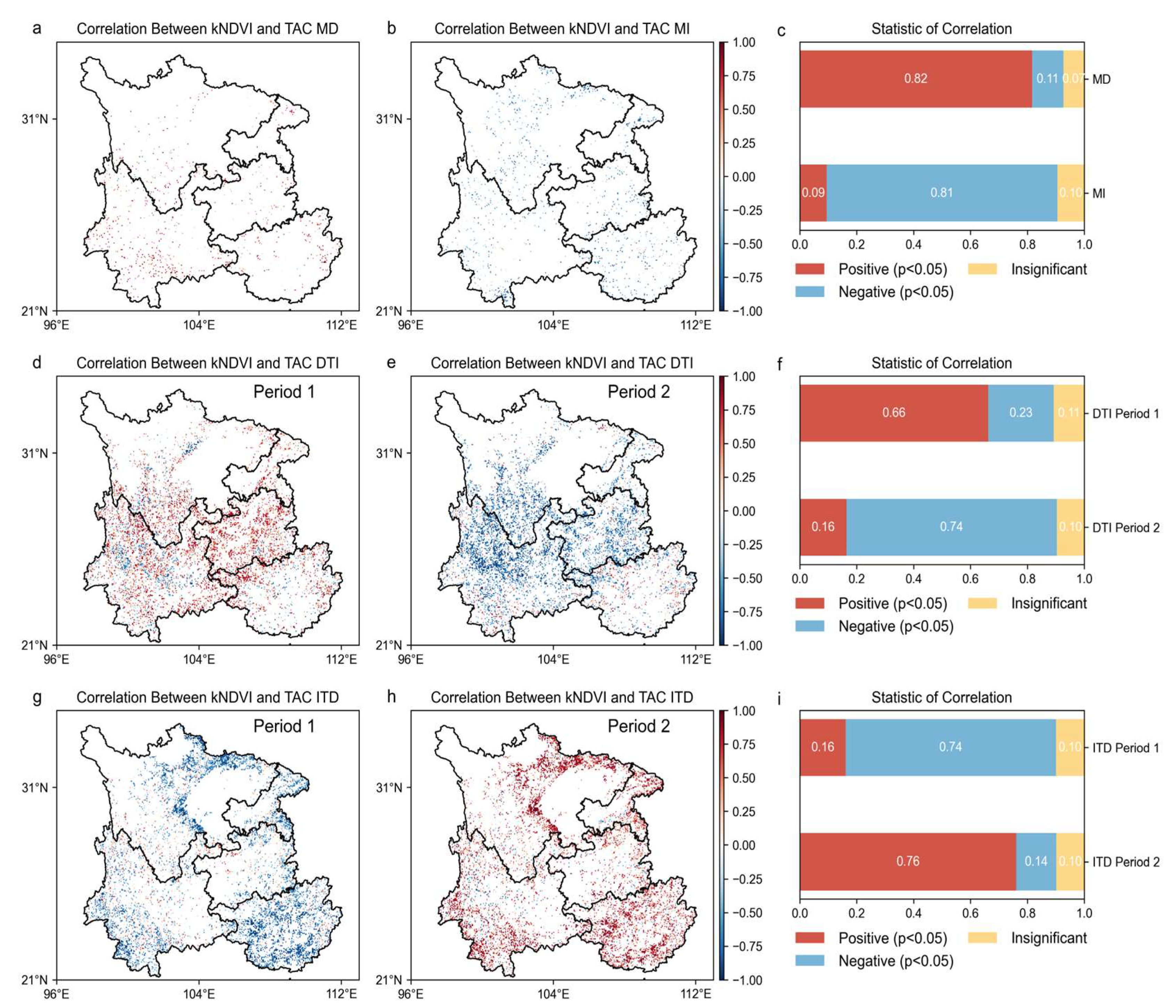

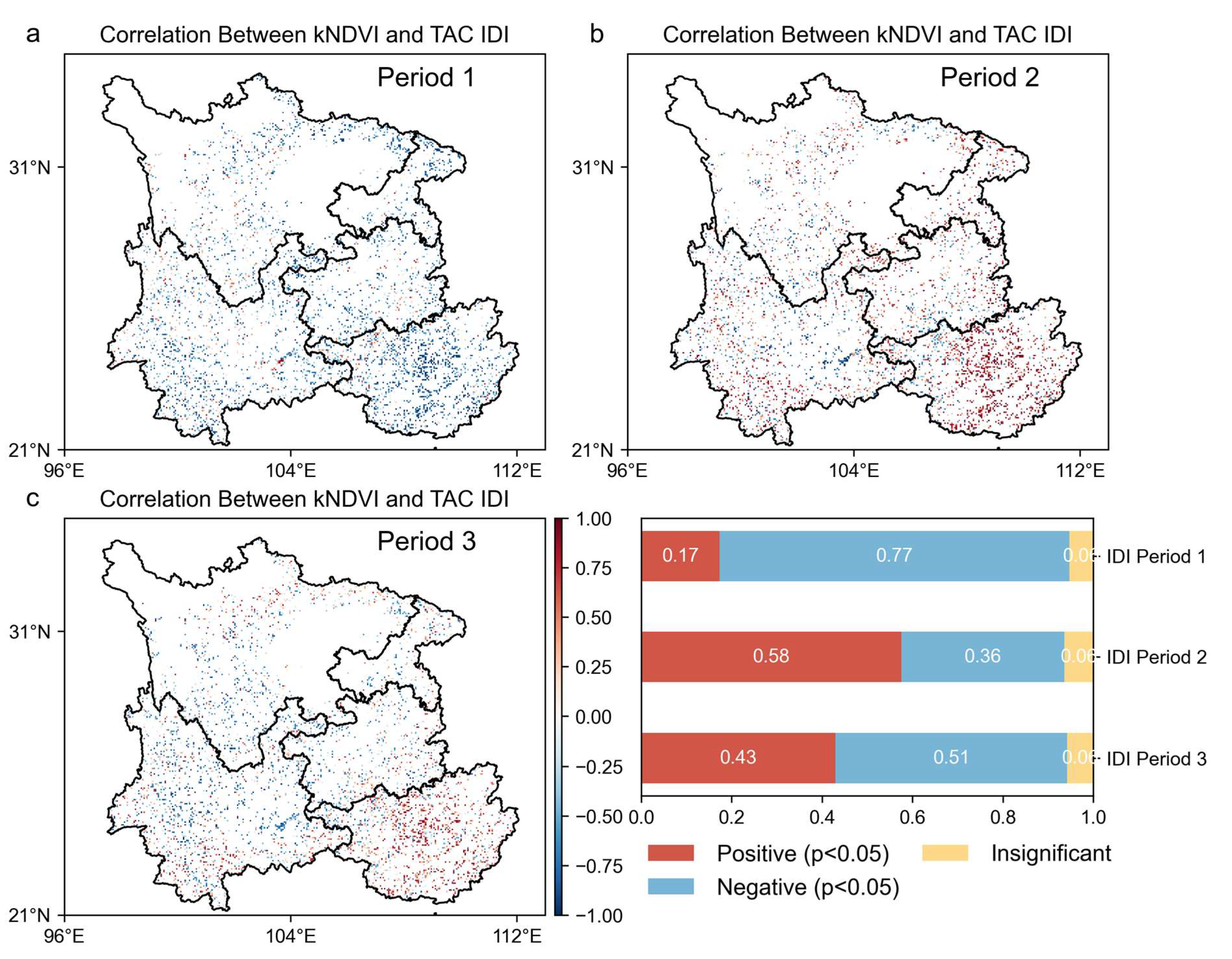

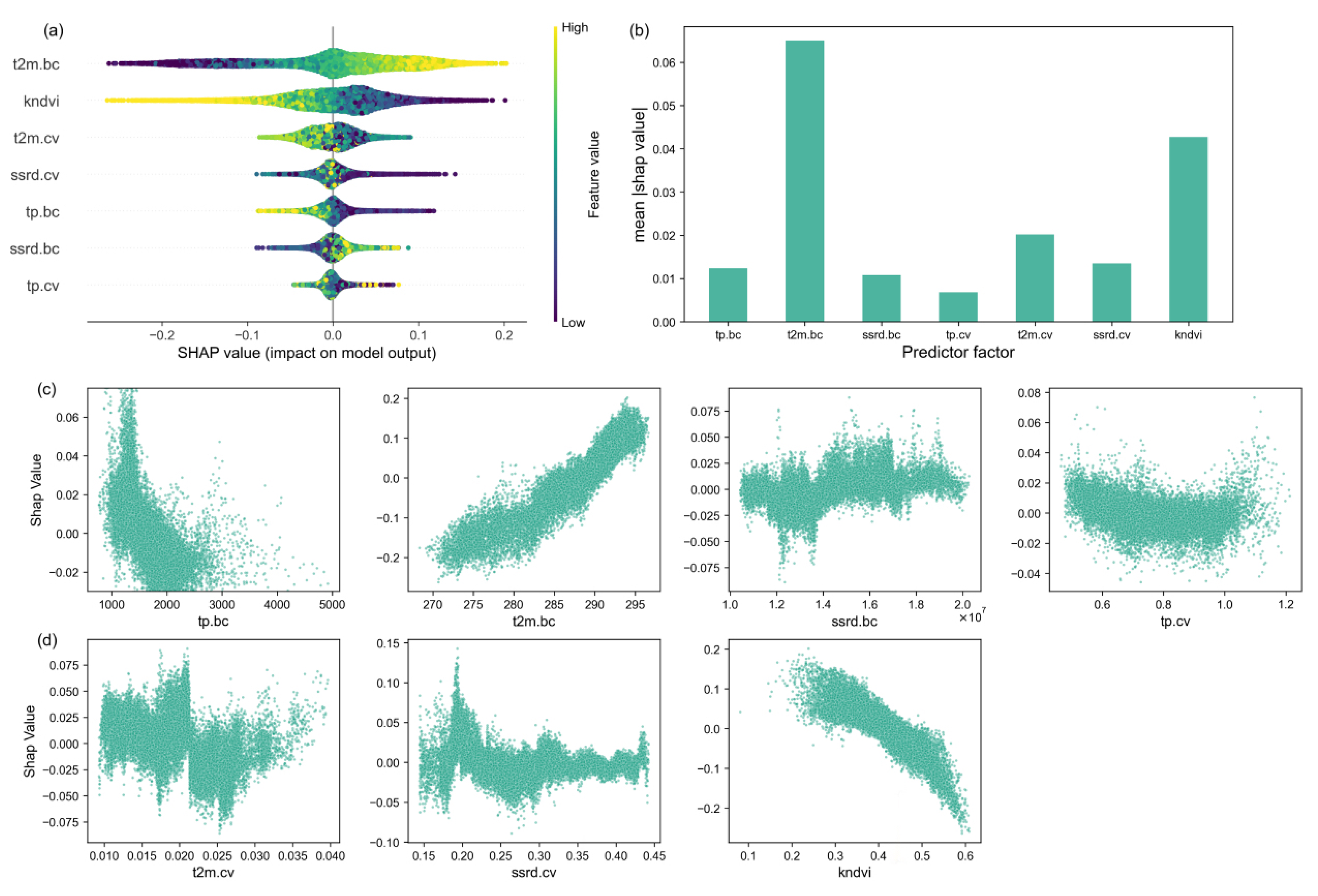
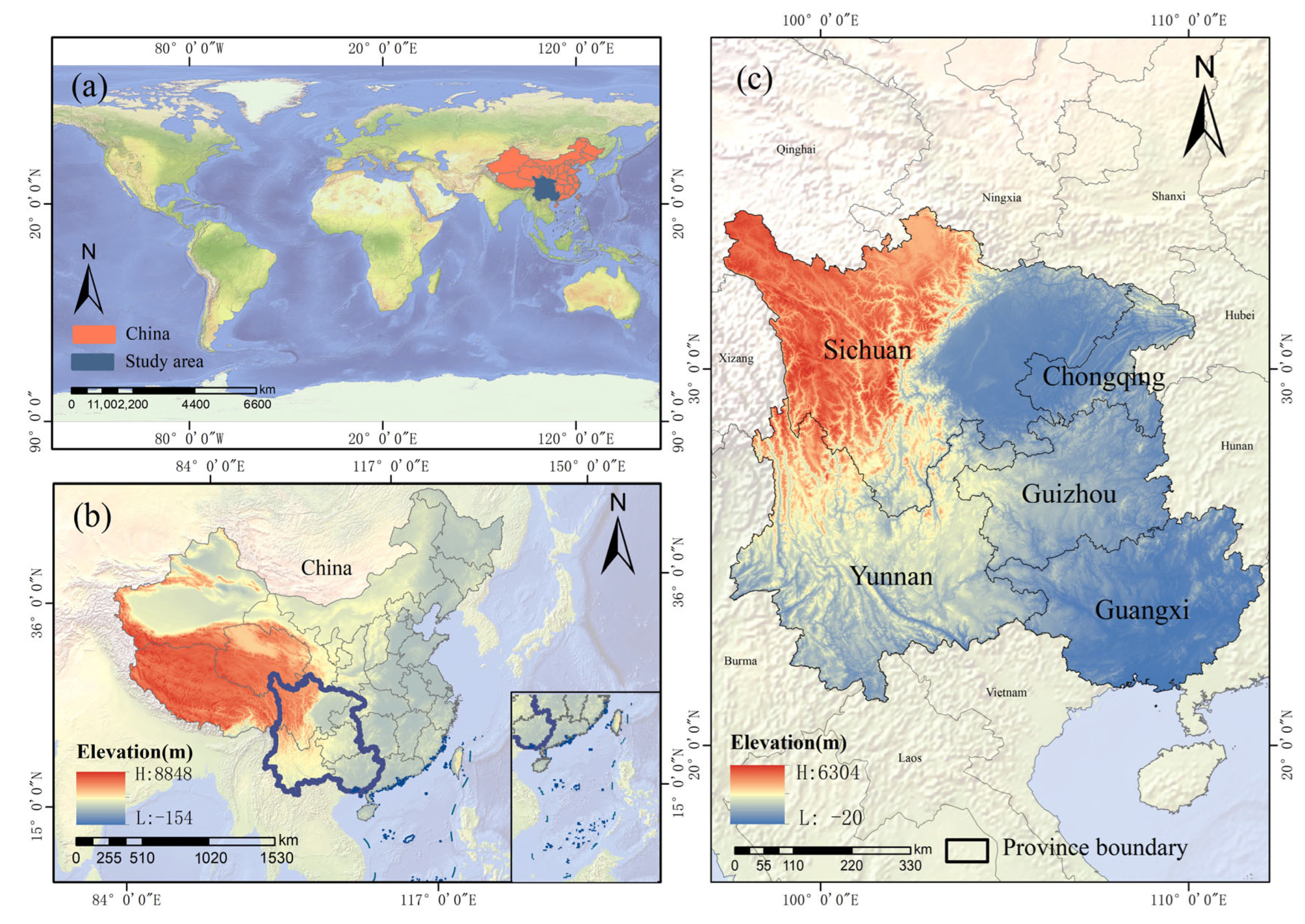
| TAC Type | Intercept | Precipitation (TP) | Temperature (T2M) | Surface Solar Radiation (SSRD) | R2 |
|---|---|---|---|---|---|
| MD | 0.2918 | –0.0440 | 0.0415 | –0.0393 | 0.8123 |
| DID-Ⅰ | 0.2889 | 0.0203 | 0.0417 | 0.0279 | 0.5763 |
| DID-Ⅱ | 0.3056 | –0.0710 | –0.0075 | –0.0453 | 0.6872 |
| MI | 0.2775 | 0.0279 | –0.0439 | 0.0258 | 0.8459 |
| IDI-Ⅰ | 0.2882 | 0.0614 | –0.0127 | –0.0404 | 0.5735 |
| IDI-Ⅱ | 0.3229 | –0.0634 | –0.0340 | –0.0431 | 0.5778 |
| DTI | 0.3142 | –0.0573 | –0.0018 | –0.0192 | 0.5932 |
| ITD | 0.2704 | 0.0309 | –0.0027 | 0.0099 | 0.2332 |
| Product | Spatial Resolution | Temporal Resolution | Source |
|---|---|---|---|
| MOD13C1 MODIS NDVI | 5 km | 16-day | https://earthdata.nasa.gov/ |
| GLC SHARE | 1 km | Yearly | https://www.un-spider.org/ |
| Temperature | 0.1° | monthly | ERA5 https://www.un-spider.org/ |
| Precipitation | 0.1° | monthly | |
| Surface Solar Radiation Downward | 0.1° | monthly |
| Type Name | Meanings |
|---|---|
| Monotonic increase (MI) | No obvious mutation was detected and the overall trend showed a monotonic increase. |
| Monotonic decrease(MD) | No obvious mutation was detected and the overall trend showed a monotonic decrease. |
| Increase then decrease (ITD) | One obvious mutation was detected and the trend shifted from an increase to a decrease. |
| Decrease then Increase (DTI) | One obvious mutation was detected and the trend shifted from a decrease to an increase. |
| Increase–decrease–increase (IDI) | Two obvious mutations were detected and the trend shifted from an increase to a decrease, then reversed back to an increase. |
| Decrease–increase–decrease (DID) | Two obvious mutations were detected and the trend shifted from a decrease to an increase and then to a decrease again. |
Disclaimer/Publisher’s Note: The statements, opinions and data contained in all publications are solely those of the individual author(s) and contributor(s) and not of MDPI and/or the editor(s). MDPI and/or the editor(s) disclaim responsibility for any injury to people or property resulting from any ideas, methods, instructions or products referred to in the content. |
© 2025 by the authors. Licensee MDPI, Basel, Switzerland. This article is an open access article distributed under the terms and conditions of the Creative Commons Attribution (CC BY) license (https://creativecommons.org/licenses/by/4.0/).
Share and Cite
Cai, L.; Luo, Y.; Lan, Y.; Shu, G.; Huang, D.; Zhou, Z.; Yan, L. Spatial and Temporal Inconsistency of Forest Resilience and Forest Vegetation Greening in Southwest China Under Climate Change. Plants 2025, 14, 2493. https://doi.org/10.3390/plants14162493
Cai L, Luo Y, Lan Y, Shu G, Huang D, Zhou Z, Yan L. Spatial and Temporal Inconsistency of Forest Resilience and Forest Vegetation Greening in Southwest China Under Climate Change. Plants. 2025; 14(16):2493. https://doi.org/10.3390/plants14162493
Chicago/Turabian StyleCai, Lu, Yining Luo, Yan Lan, Guoxiang Shu, Denghong Huang, Zhongfa Zhou, and Lihui Yan. 2025. "Spatial and Temporal Inconsistency of Forest Resilience and Forest Vegetation Greening in Southwest China Under Climate Change" Plants 14, no. 16: 2493. https://doi.org/10.3390/plants14162493
APA StyleCai, L., Luo, Y., Lan, Y., Shu, G., Huang, D., Zhou, Z., & Yan, L. (2025). Spatial and Temporal Inconsistency of Forest Resilience and Forest Vegetation Greening in Southwest China Under Climate Change. Plants, 14(16), 2493. https://doi.org/10.3390/plants14162493






